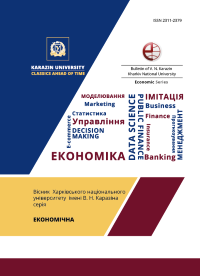Development of new alternative energy sources for sustainable energy supply
Abstract
It has been established that the needs of mankind in fuel are growing every day. The full energy balance of the countries of the European Union is analyzed and the place and share of alternative energy sources are determined. It is determined that trends in the development of society require the adoption of new, non-traditional solutions that can quickly increase the efficiency of using alternative energy sources, solve the problem of insufficient energy capacity, reduce the harmful impact on the environment and carry out modernization in the shortest possible time and at the lowest cost. The main reasons for this are the expected depletion of fossil fuel reserves, the rapid rise in prices for it, incomplete use and low efficiency, as well as the harmful impact on the environment. The problems of the energy sector of economy are determined. The use of alternative energy sources by EU countries is evaluated, which saves billions of euros on gas purchases. It is proved that despite the rapid changes in demand and oil prices, the tendency to increase the consumption of fuel and energy resources will continue, although the distribution of consumption by industries and countries may change somewhat. A review of theoretical approaches to defining the essence of the concept of «alternative energy» is made and the author's definition of this economic category is provided. Each type of alternative energy sources is characterized, their advantages and disadvantages, which positively or negatively affect the energy sector of the economy and the economy as a whole, are outlined. The problematic issues of using alternative energy sources in modern conditions of management are outlined. It is noted that in recent years, the cost of building small hydropower plants has been significantly simplified by simplifying their design and operation, standardizing design solutions, unifying equipment and full automation of HPP operation, as well as through the use of new materials and finished products. It is proposed to use new unconventional energy technologies that we have explored and can lead the world towards a sustainable energy supply.
Downloads
References
Adamenko, O., Vysochanskyi, V., Lotko, V., Mykhailiv, M. (2011). Alternative fuels and other non-traditional energy sources Ivano-Frankivsk: IME. (in Ukrainian)
Hrushka, O.G. (2008). Alternative sources of electric energy. Help. Chernivtsi: Ruta. (in Ukrainian)
Devyatkina, S.S., Shkvarnitskaya, T.Y. (2006). Alternative sources of energy. Manual. Kyiv: NAU. (in Ukrainian)
Kuvshynov, V.V. (2012). Increasing the power of serial solar installations in the combined production of thermal and electric energy. dis. For the degree of Cand. Tech. Sci.: Spec. 05.14.08 "Transformation of renewable energy" / V.V. Kuvshinov; National Academy of Sciences of Ukraine, Institute of Restoration. Energy, Kyiv. (in Ukrainian)
Legoshin, D.V. (2012). Energy efficiency of an autonomous wind turbine with rotor rotation frequency stabilization under oblique blowing conditions. dis. for the degree of Cand. Tech. Sci.: Spec. 05.14.08 "Transformation of renewable energy". National Academy of Sciences of Ukraine, Institute of Restoration. Energy, Kyiv. (in Ukrainian)
Busarev, D.V. (2014). Diversification of the world market of energy resources in the conditions of the global energy crisis. dis. for the acquisition of sciences. degree of Cand. ec. Sci. : spec. 08.00.02 "World Economy and International Economic Relations", Kyiv. (in Ukrainian)
Geletukha, G.G., Zhelezna, T.A., Prakhovnik, A.K. (2015). Analysis of energy strategies of the EU countries and the world and the role of renewable energy sources in them. Analytical note of BAU, 13, 35. (in Ukrainian)
Dzhumageldiyeva, H.D. (2016). Historical and legal prerequisites for the destruction of the regulatory influence of energy legislation of Ukraine. Economy and law, 3, 147-153. (in Ukrainian)
Konechenkov, A.E. (2022). Sector of renewable energy of Ukraine before, during and after the war. Edited by V. Omelchenko. Retrieved from https://razumkov.org.ua/statti/sektor-vidnovlyuvanoyi-energetyky-ukrayiny-do-pid-chas-ta-pislya-viyny (in Ukrainian)
Koptev, O.O. (2023). What are the advantages and disadvantages of using alternative energy: ways of development and use. Retrieved from https://opentv.media/ua/yaki-perevagi-ta-nedoliki-vikoristannya-alternativnoyi-energetiki-shlyahi-rozvitku-ta-vikoristannya (in Ukrainian)
Omelchenko, V.V. (2023). Analysis of price dynamics in the electricity market for July (after the increase in marginal prices). Retrieved from https://razumkov.org.ua/komentari/analiz-tsinovoi-dynamiky-na-rynku-elektroenergii-za-lypen-pislia-zbilshennia-granychnykh-tsin (in Ukrainian)
Chernytska, T.V. (2018). Alternative energy of the United States of America in the context of global challenges. International Economic Policy, 2 (29). Retrieved from https://journals.uran.ua/jiep/article/view/169759 (in Ukrainian)
Encyclopedia of Modern Ukraine. Retrieved from https://esu.com.ua/search?s=%D0%90%D0%9B%D0%AC%D0%A2%D0% (in Ukrainian)
Complete energy balances European Union (27 countries) - 2021 - Total - main fuel families. Complete energy balances. Retrieved from https://ec.europa.eu/eurostat/cache/infographs/energy_balances/enbal.html?geo=EU27_2020&unit=KTOE&language=EN&year=2021&fuel=fuelMainFuel&siec=TOTAL&details
Cherep, A.V., Tsyganok, K.O. (2018). Alternative sources of energy as a means of resource efficiency. Global and national problems of the economy: electronic scientific publication. Mykolaiv: Mykolaiv National University named after V.O. Sukhomlynskyi, 22, 688-692. (in Ukrainian)
Law of Ukraine "On Alternative Energy Sources". Bulletin of the Verkhovna Rada of Ukraine (VVR), 2003, No. 24, p.155 with amendments and additions No. 3220-IX dated 30.06.2023}. Retrieved from https://zakon.rada.gov.ua/laws/show/555-15#Text (in Ukrainian)
In the EU, renewables have overtaken gas for the first time. Retrieved from https://www.dw.com/uk/u-es-vidnovluvani-dzerela-energii-vperse-viperedili-gaz/a-64565674 (in Ukrainian)
Prospects for the development of alternative energy in Polissia of Ukraine / V. O. Dubrovin, L. D. Romanchuk, S. M. Kukharets [et al.]; Answer. Ed. O. V. Skydan. Kyiv: Center for Educational Literature, 2014. (in Ukrainian)
The impact of energy sources on climate change. Retrieved from https://naurok.com.ua/tvorcha-robota-vpliv-dzherel-energi-na-zminu-klimatu-260821.html (in Ukrainian)
Status and prospects for the development of small hydropower, solar, wind and other sources of renewable energy in foreign countries and Ukraine. Retrieved from https://ua.energy/wp-content/uploads/2018/01/4.-Stan-i-perspektyvy-rozvytkuPDE.pdf (in Ukrainian)
Small hydroelectric power plants of Ukraine. Retrieved from http://uk.wikipedia.org/wiki/ Mali_HPP_Ukraine(in Ukrainian)
Dyachuk, O.A., Chepelev, M.G., Podolets, R.Z., Trypolska, G.S. et al. (2017). Ukraine's Transition to Renewable Energy by 2050" / general. Ed. Yu.V. Ogarenko and O.R. Aliyeva. Pred-vo Fond im. G. Böll in Ukraine. Kyiv: ART BOOK LLC Publishing House. (in Ukrainian)

